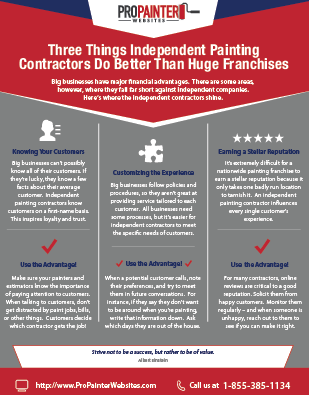Crucial Seasonal Aspects Of Commercial Outside Painting: What You Ought To Recognize
Crucial Seasonal Aspects Of Commercial Outside Painting: What You Ought To Recognize
Blog Article
Post Written By-Fox Chaney
When you're planning a business outside painting job, seasonal elements can make or break your results. You'll wish to consider exactly how temperature and moisture effect paint application and drying out times. Choosing the appropriate period can ensure your paint adheres appropriately and lasts longer. But which seasons are truly the best for this kind of work? Allow's explore the key elements that can affect your task's success.
The Impact of Temperature Level on Paint Application
When you're planning an industrial external paint job, the temperature level can substantially impact just how well the paint adheres and dries.
Ideally, you intend to paint when temperature levels range between 50 ° F and 85 ° F. If it's as well cold, the paint might not heal effectively, resulting in concerns like peeling or fracturing.
On the other hand, if it's too hot, the paint can dry too promptly, stopping correct bond and leading to an irregular finish.
You should likewise think about the time of day; morning or late afternoon provides cooler temperatures, which can be extra beneficial.
Constantly inspect the maker's referrals for the specific paint you're making use of, as they frequently give advice on the ideal temperature variety for ideal results.
Moisture and Its Result on Drying Times
Temperature isn't the only ecological variable that affects your business exterior painting project; moisture plays a considerable duty also. High humidity degrees can decrease drying out times substantially, affecting the general top quality of your paint task.
When the air is saturated with wetness, the paint takes longer to cure, which can bring about issues like bad bond and a greater threat of mildew growth. If you're painting on an especially humid day, be gotten ready for extensive wait times in between coats.
It's vital to keep an eye on regional weather and strategy accordingly. Ideally, go for humidity levels between 40% and 70% for optimum drying.
Maintaining these factors in mind ensures your project stays on track and supplies an enduring coating.
Best Seasons for Commercial Exterior Painting Projects
What's the very best time of year for your business external painting tasks?
Springtime and very early loss are typically your best bets. During these periods, temperatures are light, and humidity degrees are commonly reduced, creating ideal conditions for paint application and drying.
Avoid summer season's intense heat, which can create paint to dry also rapidly, bring about bad adhesion and finish. Likewise, winter months's cool temperature levels can hinder correct drying and healing, running the risk of the longevity of your paint work.
Go for days with temperature levels between 50 ° F and 85 ° F for optimum results. Keep in mind to check the regional weather report for rain, as damp problems can wreck your job.
Planning around https://www.westsiderag.com/2023/02/11/weekend-column-robert-beck-paints-in-dublin-house-a-splendid-irish-bar ensures your paint job runs smoothly and lasts longer.
Final thought
Finally, preparing your industrial external paint tasks around seasonal considerations can make a considerable distinction in the outcome. By organizing job during the perfect temperature levels and humidity degrees, you'll make certain much better attachment and drying out times. Remember to keep https://paxtontydin.shoutmyblog.com/34659742/residential-painters-change-your-home-s-look-utilizing-experienced-techniques on local weather prediction and pick the right time of year-- springtime and early loss are your best bets. Taking these steps will aid you attain a sturdy and professional finish that lasts.
